Bravais lattice
In geometry and crystallography, a Bravais lattice, named after Auguste Bravais (1850),[1] is an infinite array of discrete points generated by a set of discrete translation operations described in three dimensional space by:
-
(1)
where the ni are any integers and ai are primitive vectors which lie in different directions (not necessarily mutually perpendicular) and span the lattice. The choice of primitive vectors for a given Bravais lattice is not unique. A fundamental aspect of any Bravais lattice is that, for any choice of direction, the lattice will appear exactly the same from each of the discrete lattice points when looking in that chosen direction.
In crystallography, the Bravais lattice concept of an infinite array of discrete points is expanded using the concept of a unit cell which includes the space in between the discrete lattice points as well as any atoms in that space. There are two main types of unit cells: primitive unit cells and non-primitive unit cells.
A primitive unit cell for a given Bravais lattice can be chosen in more than one way (each way having a different shape), but each way will have the same volume and each way will have the property that a one-to-one correspondence can be established between the primitive unit cells and the discrete lattice points. The obvious primitive cell to associate with a particular choice of primitive vectors is the parallelepiped formed by them.[2] That is, the set of all points r of the form:
-
(2)
Using the parallelepiped defined by the primitive vectors as the unit cell has the disadvantage in some cases of not clearly revealing the full symmetry of the lattice. One solution to this is to use the Wigner-Seitz primitive cell (consisting of all points in space that are closer to the given lattice point then to any other lattice point) which does display the full symmetry of the lattice. Another solution is to use a non-primitive unit cell which does display the full symmetry of the lattice. The non-primitive unit cell volume will be an integer multiple of the primitive unit cell volume.
The unit cell, whether primitive or not, when replicated once for each discrete lattice point, must exactly fill the entire space with no overlap and no gaps.
The expanded Bravais lattice concept, including the unit cell, is used to formally define a crystalline arrangement and its (finite) frontiers. A crystal is made up of a periodic arrangement of one or more atoms (the basis or motif) occurring exactly once in each primitive unit cell. The basis may consist of atoms, molecules, or polymer strings of solid matter. Consequently, the crystal looks the same when viewed in any given direction from any equivalent points in two different unit cells (two points in two different unit cells of the same lattice are equivalent if they have the same relative position with respect to their individual unit cell boundaries).
Two Bravais lattices are often considered equivalent if they have isomorphic symmetry groups. In this sense, there are 14 possible Bravais lattices in three-dimensional space. The 14 possible symmetry groups of Bravais lattices are 14 of the 230 space groups. In the context of the space group classification, the Bravais lattices are also called Bravais classes, Bravais arithmetic classes, or Bravais flocks.[3]
In 2 dimensions
Note: In the following diagrams the lattice points are depicted using green circles and the unit cells are depicted using parallelograms (which may be squares or rectangles) outlined in black. Although each of the four corners of each parallelogram connects to a lattice point, only one of the four lattice points technically belongs to a given unit cell and each of the other three lattice points belongs to one of the adjacent unit cells. This can be seen by imagining moving the unit cell parallelogram slightly left and slightly down while leaving all the green circles of the lattice points fixed.

In two-dimensional space, there are 5 Bravais lattices,[4] grouped into four crystal families.
| Crystal family | Point group (Schönflies notation) |
5 Bravais lattices | |
|---|---|---|---|
| Primitive | Centered | ||
| Monoclinic | C2 | Oblique | |
| Orthorhombic | D2 | Rectangular | Centered rectangular |
| Hexagonal | D6 | Hexagonal | |
| Tetragonal | D4 | Square | |
The unit cells are specified according to the relative lengths of the cell edges (a and b) and the angle between them (θ). The area of the unit cell can be calculated by evaluating the norm ||a × b||, where a and b are the lattice vectors. The properties of the crystal families are given below:
| Crystal family | Area | Axial distances (edge lengths) | Axial angle |
|---|---|---|---|
| Monoclinic | a ≠ b | θ ≠ 90° | |
| Orthorhombic | a ≠ b | θ = 90° | |
| Hexagonal | a = b | θ = 120° | |
| Tetragonal | a = b | θ = 90° |
In 3 dimensions

In three-dimensional space, there are 14 Bravais lattices. These are obtained by combining one of the seven lattice systems with one of the centering types. The centering types identify the locations of the lattice points in the unit cell as follows:
- Primitive (P): lattice points on the cell corners only (sometimes called simple)
- Base-centered (A, B, or C): lattice points on the cell corners with one additional point at the center of each face of one pair of parallel faces of the cell (sometimes called end-centered)
- Body-centered (I): lattice points on the cell corners, with one additional point at the center of the cell
- Face-centered (F): lattice points on the cell corners, with one additional point at the center of each of the faces of the cell
Not all combinations of lattice systems and centering types are needed to describe all of the possible lattices, as it can be shown that several of these are in fact equivalent to each other. For example, the monoclinic I lattice can be described by a monoclinic C lattice by different choice of crystal axes. Similarly, all A- or B-centred lattices can be described either by a C- or P-centering. This reduces the number of combinations to 14 conventional Bravais lattices, shown in the table below.[5] Below each diagram is the Pearson symbol for that Bravais lattice.
Note: In the unit cell diagrams in the following table all the lattice points on the cell boundary (corners and faces) are shown; however, not all of these lattice points technically belong to the given unit cell. This can be seen by imagining moving the unit cell slightly in the negative direction of each axis while keeping the lattice points fixed. Roughly speaking, this can be thought of as moving the unit cell slightly left, slightly down, and slightly out of the screen. This shows that only one of the eight corner lattice points (specifically the front, left, bottom one) belongs to the given unit cell (the other seven lattice points belong to adjacent unit cells). In addition, only one of the two lattice points shown on the top and bottom face in the Base-centered column belongs to the given unit cell. Finally, only three of the six lattice points on the faces in the Face-centered column belongs to the given unit cell.
| Crystal family | Lattice system | Schönflies | 14 Bravais lattices | |||
|---|---|---|---|---|---|---|
| Primitive (P) | Base-centered (C) | Body-centered (I) | Face-centered (F) | |||
| Triclinic | Ci | 
aP |
||||
| Monoclinic | C2h | 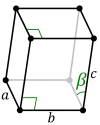
mP |

mS |
|||
| Orthorhombic | D2h | 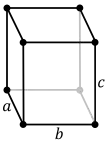
oP |

oS |

oI |

oF | |
| Tetragonal | D4h | 
tP |

tI |
|||
| Hexagonal | Rhombohedral | D3d | 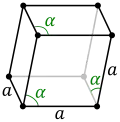
hR |
|||
| Hexagonal | D6h | 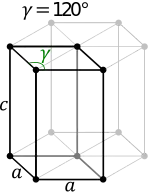
hP |
||||
| Cubic | Oh | 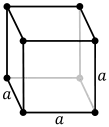
cP |

cI |

cF | ||
The unit cells are specified according to six lattice parameters which are the relative lengths of the cell edges (a, b, c) and the angles between them (α, β, γ). The volume of the unit cell can be calculated by evaluating the triple product a · (b × c), where a, b, and c are the lattice vectors. The properties of the lattice systems are given below:
| Crystal family | Lattice system | Volume | Axial distances (edge lengths)[6] | Axial angles[6] | Corresponding examples |
|---|---|---|---|---|---|
| Triclinic | (All remaining cases) | K2Cr2O7, CuSO4·5H2O, H3BO3 | |||
| Monoclinic | a ≠ c | α = γ = 90°, β ≠ 90° | Monoclinic sulphur, Na2SO4·10H2O, PbCrO3 | ||
| Orthorhombic | a ≠ b ≠ c | α = β = γ = 90° | Rhombic sulphur, KNO3, BaSO4 | ||
| Tetragonal | a = b ≠ c | α = β = γ = 90° | White tin, SnO2, TiO2, CaSO4 | ||
| Hexagonal | Rhombohedral | a = b = c | α = β = γ ≠ 90° | Calcite (CaCO3), cinnabar (HgS) | |
| Hexagonal | a = b | α = β = 90°, γ = 120° | Graphite, ZnO, CdS | ||
| Cubic | a = b = c | α = β = γ = 90° | NaCl, zinc blende, copper metal, KCl, Diamond, Silver | ||
In 4 dimensions
In four dimensions, there are 64 Bravais lattices. Of these, 23 are primitive and 41 are centered. Ten Bravais lattices split into enantiomorphic pairs.[7]
See also
References
- Aroyo, Mois I.; Müller, Ulrich; Wondratschek, Hans (2006). "Historical Introduction". International Tables for Crystallography. A1 (1.1): 2–5. CiteSeerX 10.1.1.471.4170. doi:10.1107/97809553602060000537. Archived from the original on 2013-07-04. Retrieved 2008-04-21.
- Ashcroft, Neil W. (1976). "Chapter 4". Solid State Physics. W. B. Saunders Company. p. 72. ISBN 0-03-083993-9.
- "Bravais class". Online Dictionary of Crystallography. IUCr. Retrieved 8 August 2019.
- Kittel, Charles (1996) [1953]. "Chapter 1". Introduction to Solid State Physics (Seventh ed.). New York: John Wiley & Sons. p. 10. ISBN 978-0-471-11181-8. Retrieved 2008-04-21.
- Based on the list of conventional cells found in Hahn (2002), p. 744
- Hahn (2002), p. 758
- Brown, Harold; Bülow, Rolf; Neubüser, Joachim; Wondratschek, Hans; Zassenhaus, Hans (1978), Crystallographic groups of four-dimensional space, New York: Wiley-Interscience [John Wiley & Sons], ISBN 978-0-471-03095-9, MR 0484179
Further reading
- Bravais, A. (1850). "Mémoire sur les systèmes formés par les points distribués régulièrement sur un plan ou dans l'espace" [Memoir on the systems formed by points regularly distributed on a plane or in space]. J. École Polytech. 19: 1–128. (English: Memoir 1, Crystallographic Society of America, 1949.)
- Hahn, Theo, ed. (2002). International Tables for Crystallography, Volume A: Space Group Symmetry. International Tables for Crystallography. A (5th ed.). Berlin, New York: Springer-Verlag. doi:10.1107/97809553602060000100. ISBN 978-0-7923-6590-7.
External links
- Catalogue of Lattices (by Nebe and Sloane)
- Smith, Walter Fox (2002). "The Bravais Lattices Song".